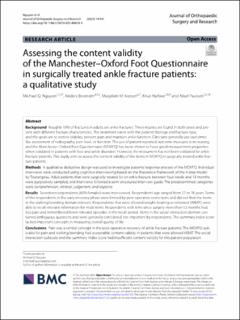| dc.contributor.author | Nguyen, Michael Quan | |
| dc.contributor.author | Broström, Anders | |
| dc.contributor.author | Iversen, Marjolein M. | |
| dc.contributor.author | Harboe, Knut | |
| dc.contributor.author | Paulsen, Aksel | |
| dc.date.accessioned | 2024-02-15T09:06:32Z | |
| dc.date.available | 2024-02-15T09:06:32Z | |
| dc.date.created | 2023-12-08T13:28:28Z | |
| dc.date.issued | 2023 | |
| dc.identifier.issn | 1749-799X | |
| dc.identifier.uri | https://hdl.handle.net/11250/3117902 | |
| dc.description.abstract | Background
Roughly 10% of fractures in adults are ankle fractures. These injuries are found in both sexes and present with different fracture characteristics. The treatment varies with the patients’ biology and fracture type, and the goals are to restore stability, prevent pain and maintain ankle function. Clinicians generally use outcomes like assessment of radiography, pain level, or function. The use of patient-reported outcome measures is increasing, and the Manchester–Oxford Foot Questionnaire (MOXFQ) has been shown to have good measurement properties when validated in patients with foot and ankle disorders. However, the instrument has not been validated for ankle fracture patients. This study aims to assess the content validity of the items in MOXFQ in surgically treated ankle fracture patients.
Methods
A qualitative deductive design was used to investigate patients’ response process of the MOXFQ. Individual interviews were conducted using cognitive interviewing based on the theoretical framework of the 4-step model by Tourangeau. Adult patients that were surgically treated for an ankle fracture between four weeks and 18 months were purposively sampled, and interviews followed a semi-structured interview guide. The predetermined categories were comprehension, retrieval, judgement, and response.
Results
Seventeen respondents (65% females) were interviewed. Respondents’ age ranged from 27 to 76 years. Some of the respondents in the early recovery phase were limited by post-operative restrictions and did not find the items in the walking/standing domain relevant. Respondents that were allowed weight-bearing as tolerated (WBAT) were able to recall relevant information for most items. Respondents with time since surgery more than 12 months had less pain and remembered fewer relevant episodes in the recall period. Items in the social interaction domain contained ambiguous questions and were generally considered less important by respondents. The summary index score lacked important concepts in measuring overall quality of life.
Conclusions
Pain was a central concept in the post-operative recovery of ankle fracture patients. The MOXFQ-subscales for pain and walking/standing had acceptable content validity in patients that were allowed WBAT. The social interaction-subscale and the summary index score had insufficient content validity for this patient population. | en_US |
| dc.language.iso | eng | en_US |
| dc.publisher | BMC | en_US |
| dc.rights | Navngivelse 4.0 Internasjonal | * |
| dc.rights.uri | http://creativecommons.org/licenses/by/4.0/deed.no | * |
| dc.title | Assessing the content validity of the Manchester–Oxford Foot Questionnaire in surgically treated ankle fracture patients: a qualitative study | en_US |
| dc.type | Journal article | en_US |
| dc.type | Peer reviewed | en_US |
| dc.description.version | publishedVersion | en_US |
| dc.rights.holder | Copyright 2023 The Author(s) | en_US |
| dc.source.articlenumber | 941 | en_US |
| cristin.ispublished | true | |
| cristin.fulltext | original | |
| cristin.qualitycode | 1 | |
| dc.identifier.doi | 10.1186/s13018-023-04418-9 | |
| dc.identifier.cristin | 2211066 | |
| dc.source.journal | Journal of Orthopaedic Surgery and Research | en_US |
| dc.identifier.citation | Journal of Orthopaedic Surgery and Research. 2023, 18, 941. | en_US |
| dc.source.volume | 18 | en_US |

